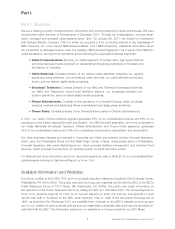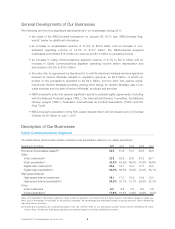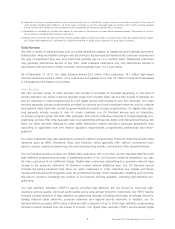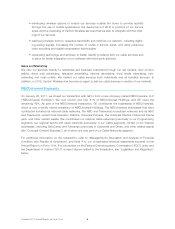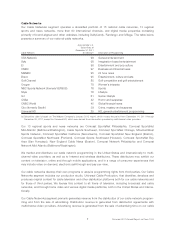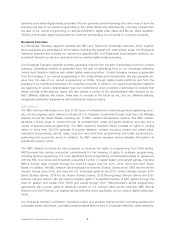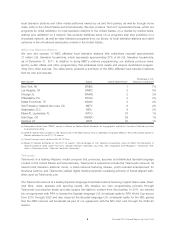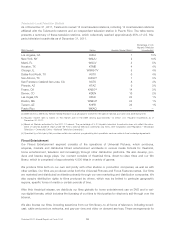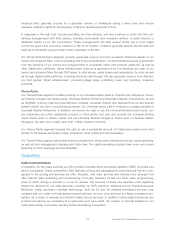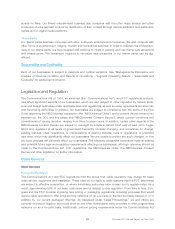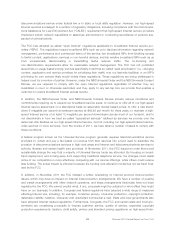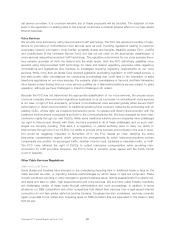Comcast 2011 Annual Report Download - page 13
Download and view the complete annual report
Please find page 13 of the 2011 Comcast annual report below. You can navigate through the pages in the report by either clicking on the pages listed below, or by using the keyword search tool below to find specific information within the annual report.
theatrical films generally provide for a specified number of exhibitions during a fixed term and include
exclusive exhibition rights for the licensing of films for specified periods of time.
In response to the high cost of producing films, we have entered, and may continue to enter, into film cofi-
nancing arrangements with third parties, including both studio and nonstudio entities, to jointly finance or
distribute certain of our film productions. These arrangements can take various forms, but in most cases
involve the grant of an economic interest in a film to an investor. Investors generally assume the full risks and
rewards of ownership proportionate to their ownership in the film.
Our Filmed Entertainment segment primarily generates revenue from the worldwide theatrical release of our
owned and acquired films, content licensing and home entertainment. Content licensing revenue is generated
from the licensing of our owned and acquired films to broadcast, cable and premium networks, as well as
other distribution platforms. Home entertainment revenue is generated from the licensing and sale of our
owned and acquired films through DVD sales to retail stores, rental kiosks and subscription by mail, as well
as through digital media platforms, including electronic sell through. We also generate revenue from distribut-
ing third parties’ filmed entertainment, producing stage plays, publishing music and licensing consumer
products.
Theme Parks
Our Theme Parks segment consists primarily of our Universal theme parks in Orlando and Hollywood. Univer-
sal Orlando includes two theme parks, Universal Studios Florida and Universal’s Islands of Adventure, as well
as CityWalk, a dining, retail and entertainment complex. Universal Orlando also features three on-site themed
hotels in which we own a noncontrolling interest. Our Universal theme park in Hollywood consists primarily of
Universal Studios Hollywood. In addition, we license the right to use the Universal Studios brand name, cer-
tain characters and other intellectual property to third parties that own and operate the Universal Studios
Japan theme park in Osaka, Japan and the Universal Studios Singapore theme park on Sentosa Island,
Singapore. We also own a water park, Wet ‘n Wild, located in Orlando.
Our Theme Parks segment licenses the right to use a substantial amount of intellectual property from third
parties for its themed elements in rides, attractions, retail outlets and merchandising.
Our Theme Parks segment generates revenue primarily from theme park attendance and per capita spending,
as well as from management, licensing and other fees. Per capita spending includes ticket price and in-park
spending on food, beverage and merchandise.
Competition
Cable Communications
Competition for the cable services we offer primarily includes direct broadcast satellite (“DBS”) providers and
phone companies. These competitors offer features, pricing and packaging for cable services that are com-
parable to the pricing and services we offer. Recently, new video services and devices have emerged that
offer Internet video streaming and downloading of movies, television shows and other video programming,
some of which charge a nominal or no fee for access. The success of these new services could negatively
impact the demand for our video services, including our DVR, premium networks and On Demand services.
Moreover, newer services in wireless technology, such as 3G and 4G wireless broadband services, may
compete with our cable and high-speed Internet services, and our voice services are facing increased com-
petition as a result of wireless and Internet-based phone services. In addition, technological advances and
product innovations are increasing at a rapid pace and, as a result, the number of choices available to our
customers is likely to increase, thereby further intensifying competition.
11 Comcast 2011 Annual Report on Form 10-K


